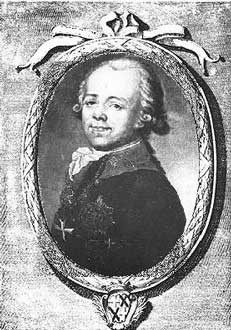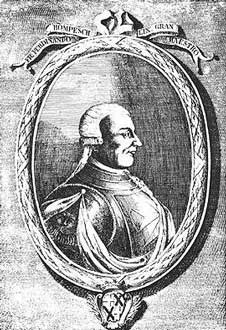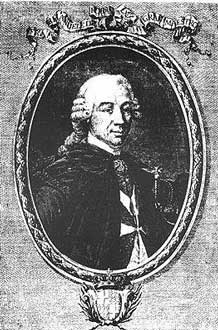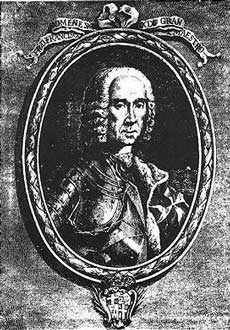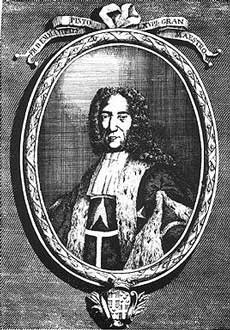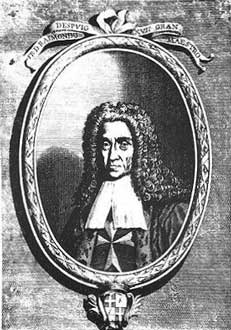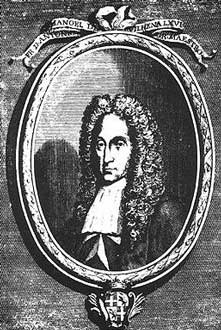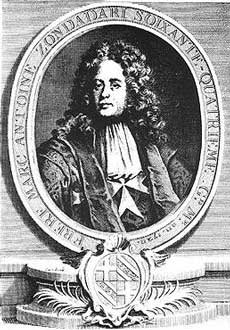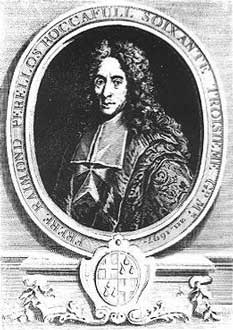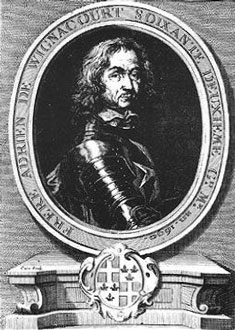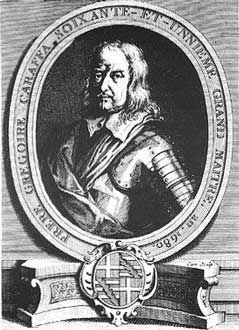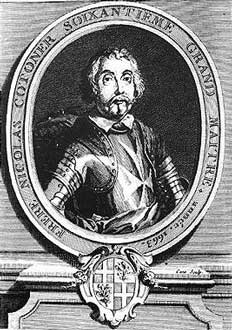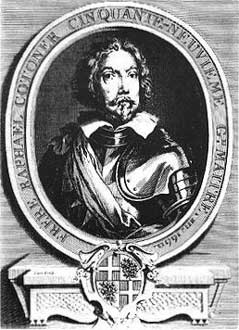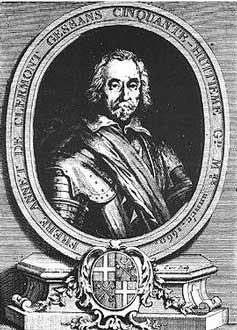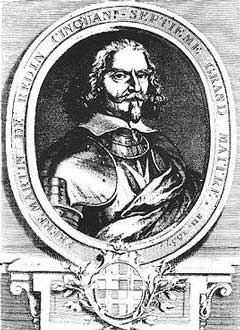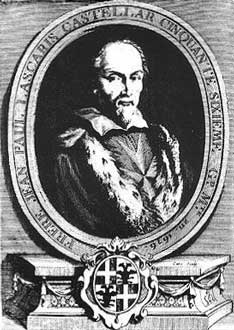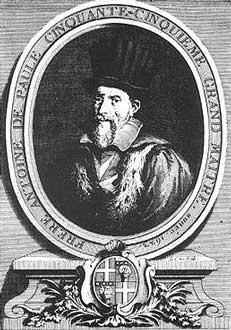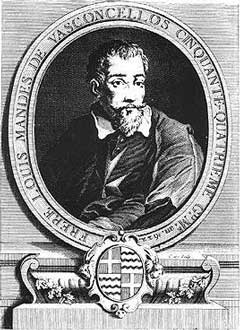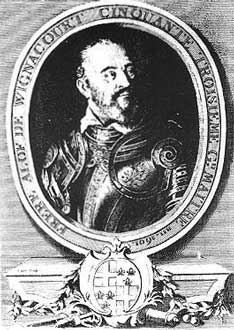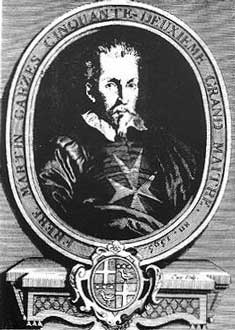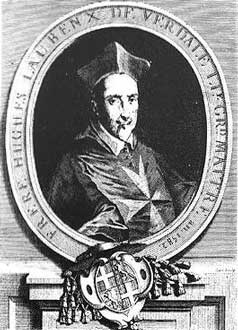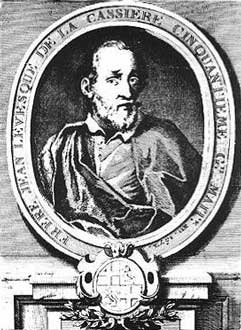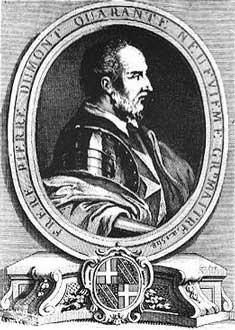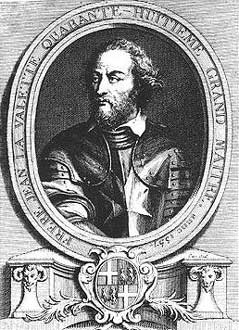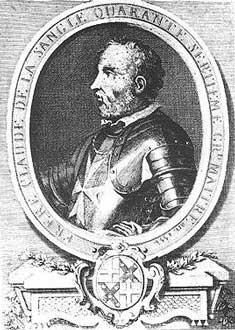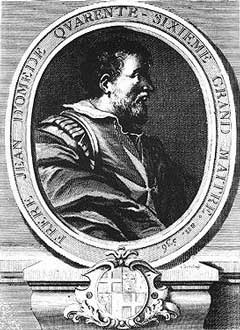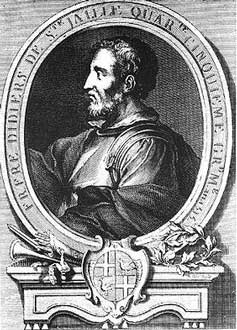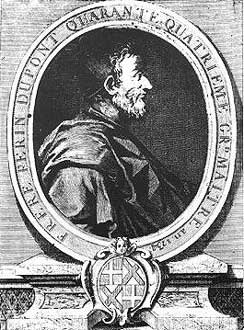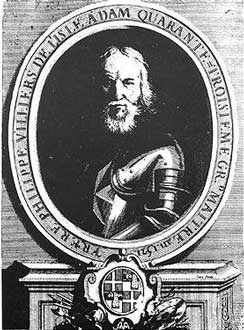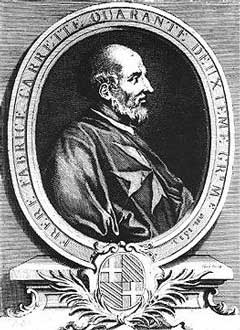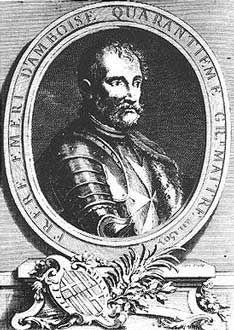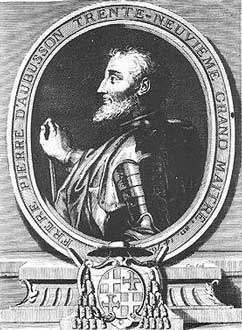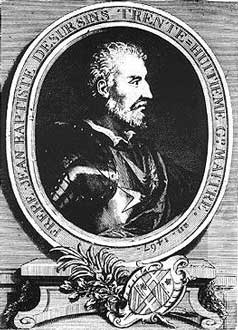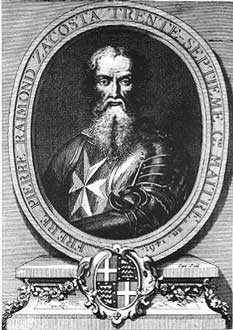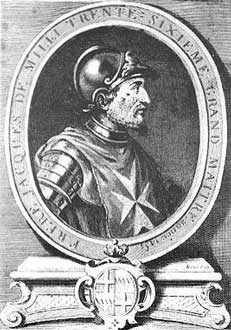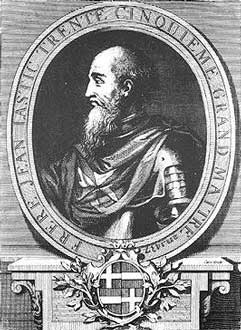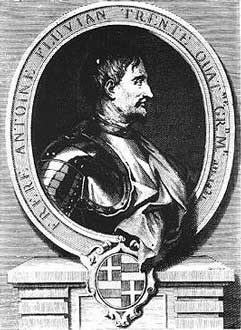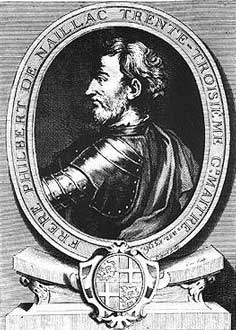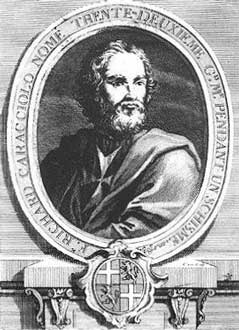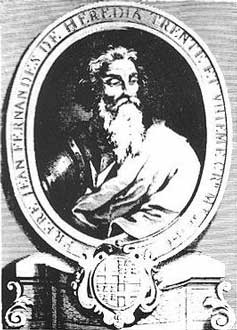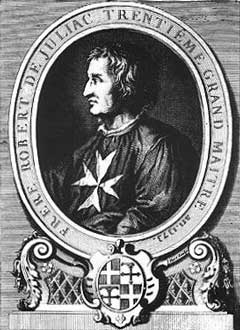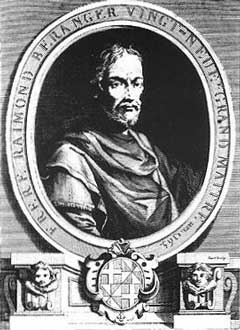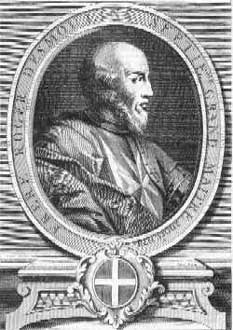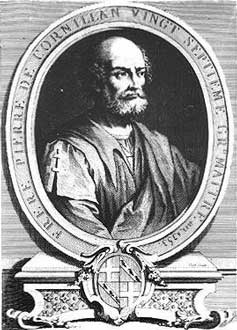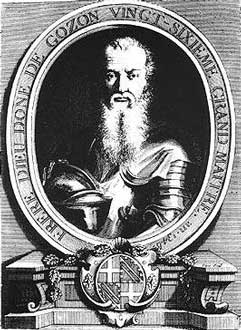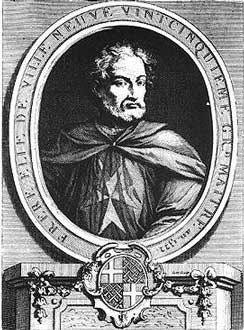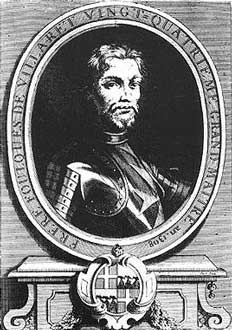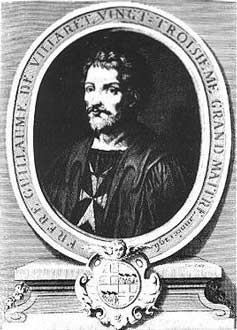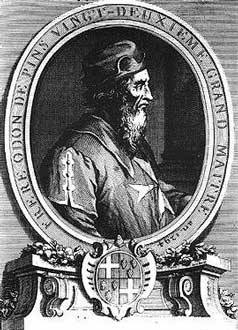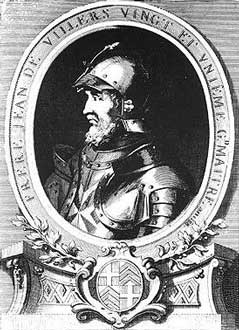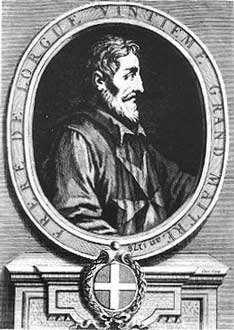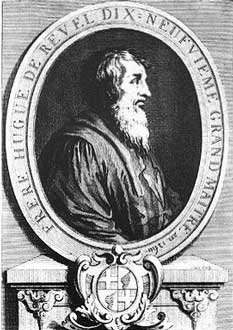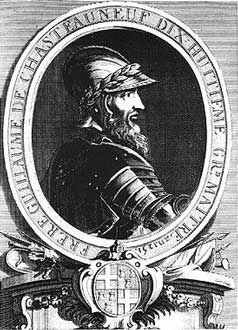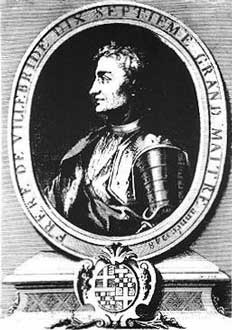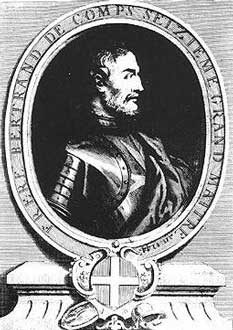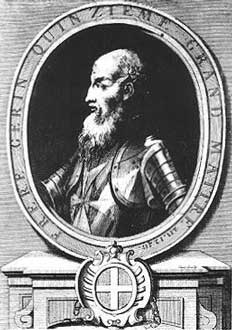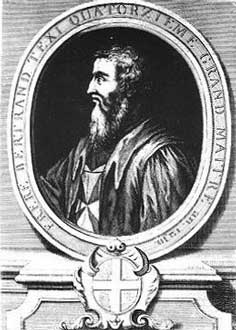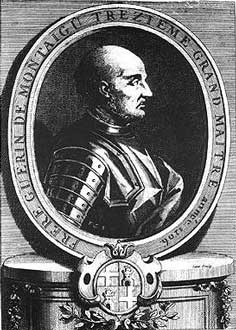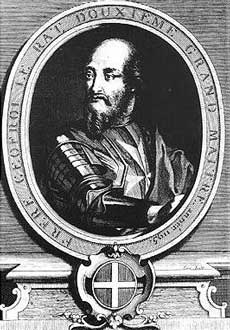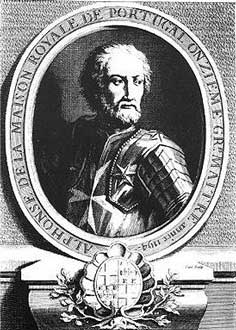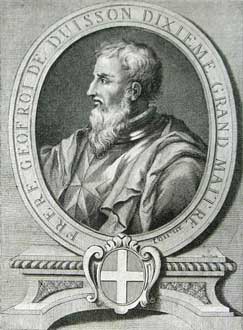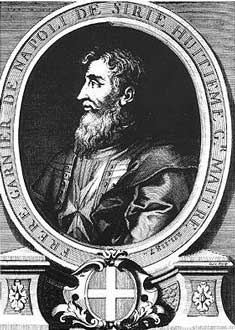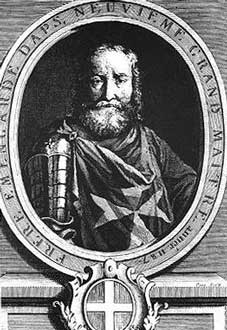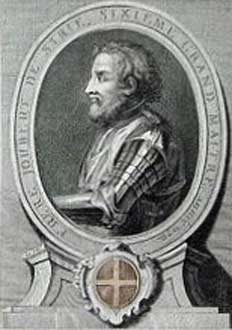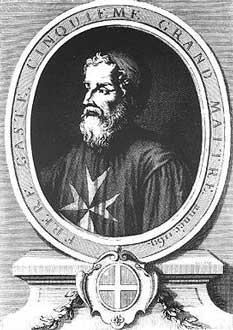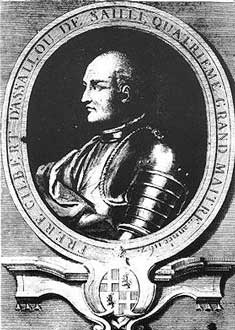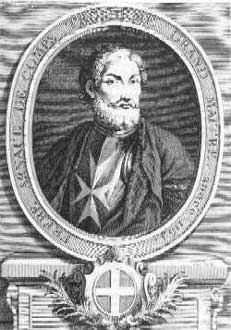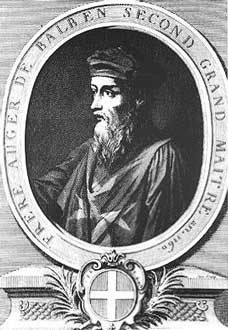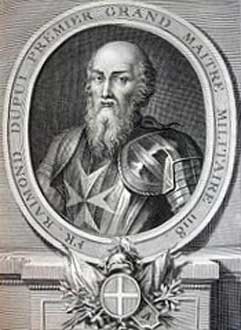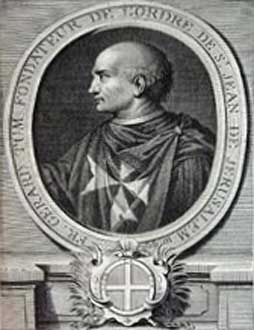THE KNIGHTS OF ST. JOHN
The Knights of St. John also known as The Order of Malta is one of the few Orders created in the Middle Ages and still active today. It is also the only one that is at the same time religious and sovereign. This is due to the fact that most of the other Orders of chivalry lacked the hospitaller function which characterises the Order of Malta, so they disappeared as soon as the military purposes that represented the reasons for their existence ceased.
The Knights of Malta
The knighthood nature explains and justifies the maintenance of the Noble nature of the Order, as most of its Religious Knights came from chivalrous and noble Christian families. Today the majority of Knights of Malta belong to all classes of society. The members of the Order may be defined as Catholics enlivened by altruistic nobleness of spirit and behaviour. All Knights of Malta must meet the traditional requirement for the bestowing of knighthood: distinguish themselves for special virtues. The knighthood nature of the Order has kept its moral value, characterised by the spirit of service, sacrifice and discipline of today’s Knights of Malta. Battles are no longer fought with swords, but with the peaceful tools of the fight against disease, poverty, social isolation and intolerance, as well as witnessing and protecting the faith.
All the 13,500 Knights and Dames of the Order of Malta are required to conduct themselves in such a way as to give Christian example in their private and public lives, thus putting into effect the tradition of the Order. It is incumbent on them to collaborate effectively in its hospitaller and social works.
The three Classes
According to the Constitution, the members of the Order of Malta are divided into three Classes. The members are to conduct their lives in an exemplary manner in conformity with the teachings and precepts of the Catholic Church and to devote themselves to the humanitarian assistance activities of the Order.
Members of the First Class are Knights of Justice, or Professed Knights, and the Professed Conventual Chaplains, who have made vows of “poverty, chastity and obedience aspiring to perfection according to the Gospel”. They are religious for all purposes of Canon Law but are not obliged to live in community.
The members of the Second Class, by virtue of the Promise of Obedience, are committed to living according to Christian principles and the inspiring principles of the Order. They are subdivided into three categories:
– Knights and Dames of Honour and Devotion in Obedience
– Knights and Dames of Grace and Devotion in Obedience
– Knights and Dames of Magistral Grace in Obedience
The Third Class consists of lay members who do not profess religious vows or the Promise, but who live according to the principles of the Church and the Order. They are divided into six categories:
– Knights and Dames of Honour and Devotion
– Conventual Chaplains ad honorem
– Knights and Dames of Grace and Devotion
– Magistral Chaplains
– Knights and Dames of Magistral Grace
– Donats (male and female) of Devotion
The relevant Grand Priory or National Association is responsible for proposals of admission.
THE KNIGHTS HOSPITALLERS
The Hospitallers probably arose as a group of individuals associated with an Amalfitan hospital in the Muristan district of Jerusalem, which was dedicated to St John the Baptist and founded around 1023 by Blessed Gerard Thom to provide care for poor, sick or injured pilgrims to the Holy Land. After the Latin Christian conquest of Jerusalem in 1099 during the First Crusade, the organisation became a religious and military order under its own Papal charter, and it was charged with the care and defence of the Holy Land. Following the conquest of the Holy Land by Islamic forces, the Order operated later from Rhodes and then later from Malta.
The Order was weakened in the Reformation, when rich commanderies of the Order in northern Germany and the Netherlands became Protestant and the Order was disestablished in England, Denmark, and elsewhere in northern Europe. The Roman Catholic order was further weakened by Napoleon’s capture of Malta in 1798 and became dispersed throughout Europe. It regained strength during the early 19th century as it redirected itself towards humanitarian and religious causes. In 1834, the Order known as the Sovereign Military Order of Malta (SMOM), acquired new headquarters in Rome where it has remained since. In 2013, the Order has 13,500 members, 80,000 volunteers, and 25,000 mostly medical employees who operate in 120 countries across the world. This includes Muslim nations and Protestant branches of the Order who engages in similar work. Recently the Order focused on developing countries in Africa, following the introduction of austerity in the Eurozone and the United Kingdom. The Order increases their attention in Europe, establishing shelters and soup kitchens to help the homeless and those suffering from hunger.
Five contemporary, state-recognised Chivalry orders which claim inheritance to the Hospitaller tradition of the “The Sovereign Military Order of Malta”, which is the original Order. Protestant orders exist and operate in Germany, the Netherlands and Sweden.
In 623, Pope Gregory I commissioned the Ravennate Abbot Probus, who was previously Gregory’s emissary at the Lombard court, to build a hospital in Jerusalem to treat and care for Christian pilgrims to the Holy Land. In 800, Charlemagne, Emperor of the Holy Roman Empire, enlarged Probus’ hospital and added a library to it. In 1005, Caliph Al Hakim destroyed the hospital and three thousand other buildings in Jerusalem with the result that merchants from Amalfi and Salerno in Italy were given permission by the Caliph Ali az-Zahir of Egypt to rebuild the hospital. This was built on the site of the monastery of Saint John the Baptist, which took refuge, Christian pilgrims travelling to the holy lands.
The monastic Hospitaller order was founded following the First Crusade by the Blessed Gerard, whose role as founder was confirmed by a Papal bull of Pope Paschal II in 1113. Gerard acquired territory and revenues for his order throughout the Kingdom of Jerusalem and beyond. Under his successor, Raymond du Puy de Provence, the hospice expanded with an infirmary not far from the Church of the Holy Sepulchre in Jerusalem. The Hospitallers main duty was to care for pilgrims, but the Order soon extended to providing pilgrims with protection. The Hospitallers and the Knights Templar became the most formidable military orders in the Holy Land. Frederick Barbarossa, the Holy Roman Emperor, pledged his protection to the Knights of St. John in a charter of privileges granted in 1185.
In 1187, Roger de Moulins provided his service to the sick; the first mention of military service is in the statutes of the ninth Grandmaster, Alonso of Portugal .In the latter a marked distinction is made between secular knights, externs to the Order, who served only for a time, and the professed knights, attached to the order by a perpetual vow, and who alone enjoyed the same spiritual privileges as the other religious. The order numbered three distinct classes of membership: the military brothers, the brothers infirmarians, and the brothers chaplains, to whom was entrusted the divine service.
The order came to distinguish itself in battle with the Muslims, its soldiers wearing a black surcoat with a white cross. In 1248 Pope Innocent IV (1243–54), approved a standard military dress for the Hospitallers to be worn in battle. Instead of a closed cape over their armour (which restricted their movements) they should wear a red surcoat with a white cross emblazoned on it.
Many of the more substantial Christian fortifications in the Holy Land were built by the Templars and the Hospitallers. At the height of the Kingdom of Jerusalem, the Hospitallers held seven great forts and 140 other estates in the area. The two largest of these, their bases of power in the Kingdom and in the Principality of Antioch, were the Krak des Chevaliers and Margat in Syria. The property of the Order was divided into priories, subdivided into bailiwicks, which in turn were divided into commandries.
As early as the late 12th century the order had begun to achieve recognition in the Kingdom of England and Duchy of Normandy. As a result, buildings such as St John’s Jerusalem and the Knights Gate, Quenington in England were built on land donated to the order by local nobility. An Irish house was established at Kilmainham, near Dublin, and the Irish Prior was usually a key figure in Irish public life.
The rising power of Islam eventually expelled the Knights from Jerusalem. After the fall of the Kingdom of Jerusalem in 1291 (Jerusalem itself fell in 1187), the Knights were confined to the County of Tripoli and, when Acre was captured in 1291, the order sought refuge in the Kingdom of Cyprus. Finding themselves becoming enmeshed in Cypriot politics, their Master, Guillaume de Villaret, created a plan of acquiring their own temporal domain, selecting Rhodes to be their new home, part of the Byzantine empire. His successor, Fulkes de Villaret, executed the plan, and on 15 August 1309, after over two years of campaigning, the island of Rhodes surrendered to the knights. They also gained control of a number of neighbouring islands and the Anatolian port of Bodrum and Kastelorizo.
Pope Clement V dissolved the Hospitallers’ rival order, the Knights Templar, in 1312 with a series of papal bulls, including the Ad providam bull, which turned over much of their property to the Hospitallers. The holdings were organised into eight “tongues” (one each in Crown of Aragon, Auvergne, Castile, England, France, Germany, Italy, and Provence). Each was administered by a Prior or, if there was more than one priory in the tongue, by a Grand Prior. At Rhodes and later Malta, the resident knights of each tongue were headed by a Bailli. The English Grand Prior at the time was Philip De Thame, who acquired the estates allocated to the English tongue from 1330 to 1358. In 1334, the Knights of Rhodes defeated Andronicus and his Turkish auxiliaries. In the 14th century, there were several other battles in which they fought.
On Rhodes the Hospitallers, by then also referred to as the Knights of Rhodes, were forced to become more militarized, having to defend themselves against the Barbary pirates. They withstood two invasions in the 15th century, one by the Sultan of Egypt in 1444 and another by the Ottoman Sultan Mehmed II in 1480 who, after capturing Constantinople and defeating the Byzantine Empire.
In 1522, 400 ships under the command of Sultan Suleiman the Magnificent delivered 100,000 men to the island. Against this force, the Knights, under Grand Master Philippe Villiers de L’Isle-Adam, had only 7,000 men-at-arms. The siege lasted six months which the surviving defeated Hospitallers were allowed to withdraw to Sicily. Despite the defeat, both Christians and Muslims seem to have regarded the conduct of Villiers de L’Isle-Adam as extremely valiant, and the Grand Master was proclaimed a Defender of the Faith by Pope Adrian VI.
After seven years of moving from place to place in Europe the Knights became established in 1530 when Charles I of Spain, and King of Sicily, gave them Malta, Gozo and the North African port of Tripoli in perpetual fiefdom in exchange for an annual fee of a single Maltese falcon , which they were to send on All Souls Day to the King’s representative, the Viceroy of Sicily, (this historical fact was used as the plot hook in Dashiell Hammett’s famous book The Maltese Falcon).
The Hospitallers continued their actions against the Muslims and especially the Barbary pirates. Although they had only a few ships they quickly drew the ire of the Ottomans, who were unhappy to see the order resettled. In 1565 Suleiman sent an invasion force of about 40,000 men to besiege the 700 knights and 8,000 Maltese soldiers.
At first the battle for the besieged was becoming desperate: dwindling daily in numbers, they were becoming too feeble to hold the long line of fortifications. The Grandmasters council suggested the abandonment of Vittoriosa and Senglea and withdrawal to Fort St. Angelo but Grand Master Jean Parisot de la Valette refused.
The Viceroy of Sicily at first had not sent help; A wrong decision could mean a defeat and exposing Sicily and Naples to the Ottomans. He had left his own son with La Valette, so he could hardly be indifferent to the fate of the fortress.
On 23 August came yet another grand assault and was the last serious effort, proved, by the besiegers. The Maltese with the greatest difficulty throw back the Turkish army.. The plight of the Turkish forces, however, was now desperate, with the exception of Fort St. Elmo, the fortifications were still intact. Working night and day the Maltese garrison had repaired the breaches, and the capture of Malta seemed more and more impossible for the Turks. Many of the Ottoman troops in crowded quarters had fallen ill due to lack of ,water and the heat of the summer months. Ammunition and food were beginning to run short, and the Ottoman troops were becoming increasingly dispirited by the failure of their attacks and their losses. on 23 June The death of commander Dragut, a corsair and admiral of the Ottoman fleet, was a serious blow. The Turkish commanders, Piyale Pasha and Mustafa Pasha lacked the leadership.
On 1 September they made their last effort, but the morale of the Ottoman troops had deteriorated seriously and the attack was feeble, to the great encouragement of the besieged, who now began to see hopes of deliverance. The perplexed and indecisive Ottomans heard of the arrival of Sicilian reinforcements in Mellieħa Bay. Unaware that the force was very small, they broke off the siege and left Malta on 8 September. The Great Siege of Malta may have been the last action in which a force of knights won a decisive victory.
When the Ottomans departed, the Maltese and Hospitallers had but 600 men able to bear arms. The most reliable estimate puts the number of the Ottoman army at its height losing some 40,000 men, of whom 15,000 eventually returned to Constantinople. The siege is portrayed vividly in the frescoes of Matteo Perez d’Aleccio in the Hall of St. Michael and St. George, also known as the Throne Room, in the Grand Master’s Palace in Valletta; four of the original modellos, painted in oils by Perez d’Aleccio between 1576 and 1581, can be found in the Cube Room of the Queen’s House at Greenwich, London. After the siege a new city had to be built: the present capital city of Malta, named Valletta in memory of the Grand Master who had withstood the siege.
In 1607, the Grand Master of the Hospitallers was granted the status of Reichsfürst (Prince of the Holy Roman Empire, even though the Order’s territory was always south of the Holy Roman Empire). In 1630, he was awarded ecclesiastic equality with cardinals, and the unique hybrid style His Most Eminent Highness, reflecting both qualities qualifying him as a true Prince of the Church.
Following the Knights’ re-establishment on Malta, they had found themselves devoid of their initial reason for existence: assisting and joining the crusades in the Holy Land was now impossible, for reasons of military and financial strength along with geographical position. With dwindling revenues from European sponsors no longer willing to support a costly and meaningless organization, the Knights turned to policing the Mediterranean from the increased threat of piracy, most notably from the threat of the Ottoman-endorsed Barbary Corsairs operating from the North African coastline. Boosted towards the end of the 16th century by an air of invincibility following the successful defence of their island in 1565 and compounded by the Christian victory over the Ottoman fleet in the Battle of Lepanto in 1571, the Knights and maltese set about protecting Christian merchant shipping to and from the Levant and freeing the captured Christian slaves who formed the basis of the Barbary corsairs’ piratical trading and navies. This became known as the ‘corso’.
Knights went beyond their call of duty by raiding Muslim ships. More and more ships were plundered, from the profits of which many Knights lived idly and luxuriously, taking local women to be their wives and enrolling in the navies of France and Spain in search of adventure, experience, and yet more money.
The knights’ changing attitudes were coupled with the effects of the Reformation and Counter-Reformation and the lack of stability from the Roman Catholic Church. All this affected the Knights strongly as the 16th and 17th centuries saw a gradual decline in the religious attitudes of many of the Christian peoples of Europe (and, concomitantly, the importance of a religious army), and thus in the Knights’ regular tributes from European nations. That the Knights, a Roman Catholic military order, pursued the readmittance of England as one of its member states — the Order there had been suppressed, along with monasteries, under King Henry VIII — upon the succession of the Protestant Queen Elizabeth I aptly demonstrates the new religious tolerance within the Order. For a time, the Order even possessed a German tongue which was part Protestant and part Roman Catholic.
The perceived moral decline that the Knights underwent over the course of this period is best highlighted by the decision of many Knights to serve in foreign navies and become “the mercenary sea-dogs of the 14th to 17th centuries”, with the French Navy proving the most popular destination. This decision went against the Knights’ cardinal reason for existence, in that by serving a European power directly they faced the very real possibility that they would be fighting against another Catholic force, as in the few Franco-Spanish naval skirmishes that occurred in this period. The biggest paradox is the fact that for many years the French remained on amicable terms with the Ottoman Empire, the Knights’ greatest and bitterest foe and purported sole purpose for existence. Paris signed many trade agreements with the Ottomans and agreed to an informal (and ultimately ineffective) cease-fire between the two states during this period. That the Knights associated themselves with the allies of their sworn enemies shows their moral ambivalence and the new commercial-minded nature of the Mediterranean in the 17th century. Serving in a foreign navy, in particular that of the French, gave the Knights the chance to serve the Church and for many, their King, to increase their chances of promotion in either their adopted navy or in Malta, to receive far better pay, to stave off their boredom with frequent cruises, to embark on the highly preferable short cruises of the French Navy over the long caravans favoured by the Maltese, and if the Knight desired, to indulge in some of the pleasures of a traditional debauched seaport. In return, the French gained and quickly assembled an experienced navy to stave off the threat of the Spanish and their Habsburg masters. The shift in attitudes of the Knights over this period is ably outlined by Paul Lacroix who states.
“Inflated with wealth, laden with privileges which gave them almost sovereign powers … the order at last became so demoralised by luxury and idleness that it forgot the aim for which it was founded, and gave itself up for the love of gain and thirst for pleasure. Its covetousness and pride soon became boundless. The Knights pretended that they were above the reach of crowned heads: they seized and pillaged without concern of the property of both infidels and Christians”.
With the Knights’ exploits growing in fame and wealth, the European states became more complacent about the Order, and more unwilling to grant money to an institution that was perceived to be earning a healthy sum on the high seas. Thus a vicious cycle occurred, increasing the raids and reducing the grants received from the nation-states of Christendom to such an extent that the balance of payments on the island had become dependent on conquest. The European powers lost interest in the Knights as they focused their intentions largely on one another during the Thirty Years War. In February 1641 a letter was sent from an unknown dignitary in the Maltese capital of Valletta to the Knights’ most trustworthy ally and benefactor, Louis XIV of France, stating the Order’s troubles.
“Italy provides us with nothing much; Bohemia and Germany hardly anything, and England and the Netherlands for a long time now nothing at all. We only have something to keep us going, Sire, in your own Kingdom and in Spain.”
It is important to note that the Maltese authorities would neglect to mention the fact that they were making a substantial profit policing the seas and seizing “infidel” ships and cargoes. The authorities on Malta immediately recognised the importance of corsairing to their economy and set about encouraging it, as despite their vows of poverty, the Knights were granted the ability to keep a portion of the ‘spoglio’, which was the prize money and cargo gained from a captured ship, along with the ability to fit out their own galleys with their new wealth.
The great controversy that surrounded the Knights’ ‘corso’ was their insistence on their policy of ‘vista’. This enabled the Order to stop and board all shipping suspected of carrying Turkish goods and confiscate the cargo to be re-sold at Valletta, along with the ship’s crew, who were by far the most valuable commodity on the ship. Naturally many nations claimed to be victims of the Knights’ over-eagerness to stop and confiscate any goods remotely connected to the Turks. In an effort to regulate the growing problem, the authorities in Malta established a judicial court, the Consiglio del Mer, where captains who felt wronged could plead their case, often successfully. The practice of issuing privateering licenses and thus state endorsement, which had been in existence for a number of years, was tightly regulated as the island’s government attempted to haul in the unscrupulous Knights and appease the European powers and limited benefactors. Yet these efforts were not all successful as the Consiglio del Mer contains numerous accounts from around the year 1700 of complaints of Maltese piracy in the region. Ultimately, the rampant over-indulgence in privateering in the Mediterranean was to be the Knights’ downfall in this particular period of their existence as they transformed from serving as the military outpost of a united Christendom to becoming another nation-state in a commercially oriented continent soon to be overtaken by the trading nations of the North Sea.
Having chosen Malta, the Knights stayed for 268 years, transforming what they called “merely a rock of soft sandstone” into a flourishing island with mighty defences and a capital city (Valletta) known as Superbissima, “Most Proud”, amongst the great powers of Europe.
In 1301, the Order was organized in seven Langues, by order of precedence: Provence, Auvergne, France, Aragon, Italy, England, and Germany. In 1462, the Langue of Aragon was divided into Castile-Portugal and Aragon-Navarre. The English Langue went into abeyance after the order’s properties were taken over by Henry VIII in 1540. In 1782, it was revived as the Anglo-Bavarian Langue, containing Bavarian and Polish priories. The structure of langues was replaced in the late 19th century by a system of national associations.
Not surprisingly, hospitals were among the first projects to be undertaken on Malta, where French soon supplanted Italian as the official language (though the native inhabitants continued to speak Maltese among themselves).[citation needed] The knights also constructed fortresses, watch towers, and naturally, churches. Its acquisition of Malta signalled the beginning of the Order’s renewed naval activity.
The building of the new Capital City of Valletta, named for Grand Master la Valette, was begun in 1566, soon becoming the home port of one of the Mediterranean’s most powerful navies. Valletta was designed by Francesco Laparelli, a military engineer, and his work was then taken up by Ġlormu Cassar. The city was completed in 1571. The island’s hospitals were enlarged. The main Hospital could accommodate 500 patients and was famous as one of the finest in the world. At the vanguard of medicine, the Hospital of Malta included Schools of Anatomy, Surgery and Pharmacy. Valletta itself was renowned as a centre of art and culture. The Church of St. John the Baptist, completed in 1577, contains works by Caravaggio and other Masters.
In Malta, the Public Library was also established in 1761. The University was founded seven years later, followed, in 1786, by a School of Mathematics and Nautical Sciences.
In 1604, each Langue was given a chapel in the conventual church of St. John and the arms of the Langue appear in the decoration on the walls and ceiling:
Even as it survived on Malta, the Order lost many of its European holdings following the rise of Protestantism. The property of the English branch was confiscated in 1540. The German Bailiwick of Brandenburg became Lutheran in 1577 but continued to pay its financial contribution to the Order until 1812, when the Protector of the Order in Prussia, King Frederick William III, turned it into an order of merit; in 1852, his son and successor as Protector, King Frederick William IV, restored the Johanniterorden to its continuing place as the chief Protestant branch of the Knights Hospitaller.
The Knights of Malta had a strong presence within the Imperial Russian Navy and the pre-revolutionary French Navy. When De Poincy was appointed governor of the French colony on St. Kitts in 1639, he was a prominent Knight of St. John and dressed his retinue with the emblems of the Order. In 1651, the Knights bought from the Compagnie des Îles de l’Amérique the islands of Sainte-Christophe, Saint Martin, and Saint Barthélemy. The Order’s presence in the Caribbean was eclipsed with De Poincy’s death in 1660. He had also bought the island of Saint Croix as his personal estate and deeded it to the Knights of St. John. In 1665, the order sold their Caribbean possessions to the French West India Company, ending the Order’s presence in that region.
The decree of the French National Assembly in 1789 abolishing feudalism in France also abolished the Order in France.
Titles of every description, as well as the dues which have been substituted for them, under whatever denomination they are known or collected, possessed by secular or regular congregations, by holders of benefices, members of corporations, as well as those devoted to the maintenance of churches, those impropriated to lay persons and those substituted for the portion congrue, are abolished.
The French Revolutionary Government seized the assets and properties of the Order in France in 1792.
The Mediterranean stronghold of Malta was captured by Napoleon in 1798 during his expedition to Egypt. Napoleon demanded from Grand Master Ferdinand von Hompesch zu Bolheim that his ships be allowed to enter the port and to take on water and supplies. The Grand Master replied that only two foreign ships could be allowed to enter the port at a time. Bonaparte, aware that such a procedure would take a very long time and would leave his forces vulnerable to Admiral Nelson, Napoleon immediately ordered a cannon fusillade against the Island. The French soldiers disembarked in Malta on the morning of 11th June and attacked. After several hours of fierce fighting, the Maltese in the west side of Malta were forced to surrender. The Grand Master Ferdinand von Hompesch zu Bolheim negotiated surrender to the invasion. Hompesch left Malta for Trieste on 18th June and resigned as Grand Master on 6 July 1799.
The knights were dispersed, but the order continued to exist in a diminished form and negotiated with European governments for a return to power. The Russian Emperor, Paul I, gave the largest number of knight’s shelter in St. Petersburg and boosted the Order’s recognition among the Russian Imperial Orders. The knights in St Petersburg proceeded to elect Tsar Paul as their Grand Master. Grand Master Paul I created, in addition to the Roman Catholic Grand Priory, a “Russian Grand Priory”. Paul’s election as Grand Master was, however, never ratified under Roman Catholic canon law, and he was the de facto rather than de jure Grand Master of the Order.
By the early 19th century, the order had been severely weakened by the loss of its priories throughout Europe. Only 10% of the order’s income came from traditional sources in Europe, with the remaining 90% being generated by the Russian Grand Priory until 1810. This was partly reflected in the status of the Order as Lieutenants, rather than Grand Masters where reining the Order. Later in the period 1805 to 1879, Pope Leo XIII restored a Grand Master to the order. This signalled the renewal of the order’s fortunes as a humanitarian and religious organization.
In 1834, the order settled in Rome. Hospital work, the original work of the order, once again became its main concern. The Order’s hospital and welfare activities, undertaken in World War I was on a considerable scale and were greatly intensified and expanded in World War II under the Grand Master Fra’ Ludovico Chigi Albani della Rovere (Grand Master 1931–1951).
The Sovereign Military Hospitaller Order of Saint John of Jerusalem, of Rhodes and of Malta, better known as the Sovereign Military Order of Malta (SMOM), is a Roman Catholic religious order and the world’s oldest surviving order of chivalry. Its sovereign status is recognised by membership in numerous international bodies and observer status at the United Nations and many others.
THE GREAT SIEGE
If it had not taken place, the Great Siege would no doubt have been dreamt up for the screenplay of an epic film. Few other historic episodes rival it for sheer heroism, the bloodshed of war and military strategy. Voltaire is quoted as saying ‘rien est plus connu que la siege de Malte’, nothing is as well known as the Siege of Malta.
The story of the Siege is interwoven with the tale of two adversaries, the ageing Grand Master Jean Parisot de la Valette, and his contemporary, the Barbary corsair Rais Dragut who commanded the fleet of Sultan Suleiman the Magnificent. It is also the story of thousands of lives of Maltese Islanders, men at arms to the Knights of St. John.
The years leading up to the Siege saw the Islands under constant threat from the Ottoman Turks. In 1551, the Ottomans carried out an audacious raid, which saw most of Gozo’s population captured and taken into slavery. In 1559, the Knights responded, but with a disastrous attack on the Ottoman stronghold, Djerba, on the Tunisian coast.
The Knights knew they were vulnerable in Malta despite the harbours and their two forts, St. Angelo, in what is now Vittoriosa, and newly-built St. Elmo, on the open peninsula of Mount Sciberras overlooking the harbours, later known as Grand Harbour and Marsamxett Harbour.
Grand Master La Valette had done his best to build defences and had requested extra forces from the Emperor Charles V, the Pope and the Viceroy of Sicily.
But no help came. In May, 1565, a vast Ottoman fleet, with some 40,000 men, lay siege to the Islands. The Knights with a mere 700 or so men and around 8000 Maltese regular troops were heavily outnumbered . The Islanders took refuge in the fortified towns of Mdina and Birgu destroying crops and poisoning wells as they fled.
The Ottomans first decided to attack the isolated Fort St. Elmo, because of its commanding position between the two harbours. Repeated assaults were launched over 36 days, but the small garrison of Knights held on to the fort for far longer than Suleiman’s men anticipated. After four weeks, they finally overran St. Elmo but at a heavy price: the loss of 8000 men. The Turkish commander Dragut was fatally injured during the taking of St. Elmo. Under his co-commander, Mustafa Pasha, the Ottoman troops now had St. Angelo in their sights.
It is the battle for St. Angelo which saw some of the bloodiest episodes of this Holy War and the basis of legends for centuries to come throughout the long, hot summer of 1565.. Mustafa Pasha was to launch some 10 attacks on the walls of St. Angelo and the fortified Three Cities. Even on 18th August, when a huge part of the defences were breached, the Ottomans failed to take the Fort. Vallette himself had even entered the battle fray and despite the uneven odds for success, he had refused to accept the Ottoman’s terms of surrender.
At one point in the battle, the Ottomans floated the headless corpses of captured Knights across Grand Harbour. The act was returned in kind: Vallette ordered all Ottoman prisoners to be executed and their heads used as ‘cannon balls’ to fire back toward their compatriots in St Elmo.
By September, the Ottomans were concerned about having to remain in Malta during the winter, and their morale began to ebb. At this point, Vallette’s long-awaited relief forces appeared at Mellieħa Bay and took control of high ground inland. Almost trapped, the Ottoman troops retreated, but not before losing thousands more men.
The Great Siege ended on 8th September, commemorated today with a public holiday, il-Vitorja. The epilogue to the Siege was twofold: the Knights of St. John in Malta had seriously diminished the power of the Ottomans and Malta’s magnificent capital, Valletta, was founded by and named after Grand Master Jean de la Valette. Valletta was to be not only a fortress city, but the cultural home to some of the finest works of 16th – 18th century Europe. Vallette himself was buried in the city some three years later.


